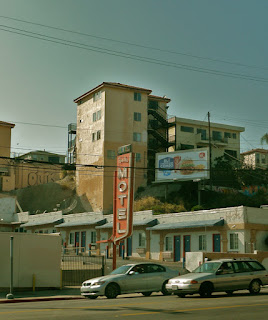 How do you manipulate images in the computer to obtain a grayscale tone map.
How do you manipulate images in the computer to obtain a grayscale tone map.It is very easy in Photoshop or any other paint package with similar functions. You can do this to any image you want to paint to aid you in discovering the true tones or families of related tones.
Let's start with a random image. Here is one of a Motel in L.A.
It is a not a very complicated image but it can be tricky to determine what are the prevalent tonal values just by looking at it.
PHOTOSHOP INSTRUCTIONS:
Image > Mode > Grayscale (discard color info , yes, but do not save the image over the old one)
Second, let's posterize . There are infinite ways of doing this.
Posterize just removes all gradations and returns an image with the amount of levels you specify.
Image >Adjustment> Posterize (level 3)
Third:
Because it's a little grainy, let's blur it a bit.
Filters>Gaussian blur.
Fourth :
Posterize yet again
And there you have it.The Motel reduced to grayscale. I bet you didn't guess the sky was closer in value to the asphalt.




2 comments:
You're right, I wouldn't have figured out the values this way. But can I ask a potentially mean question: is there a point where too much computer altering and fixing is somewhat 'cheating'?
This editing down of a photo is certainly helpful, and gets rid of confusion. But I've seen painters take a photo, alter it down so much (cropping, colorizing, filtering etc.) that they end up just straight copying in paint the Photoshop image. I assume this retards the development of their own eye for plein air. Sorry if I sound picky.
Yes Judy, it is cheating. No doubt about it. One can be forgiven for thinking it is a learning tool instead of a cheat but who am I kidding. I should also make a post about portrait artists that use the computer to overlap a painting with the photograph and determine if they are missing semblance, proportions, etc...There's more than care to admit it. However, there is a lot of things the grayscale doesn't "solve, for example the chroma (color) with which on might achieve the tonal consistency, the composition and the brushwork. After all, painting is not copying at all. Reality is just an starting point and although accuracy is an essential tool, it is not even a tiny part of what makes a paint sing. I say use all the help you need to push your art forward without relying too much on the crutches.
Post a Comment